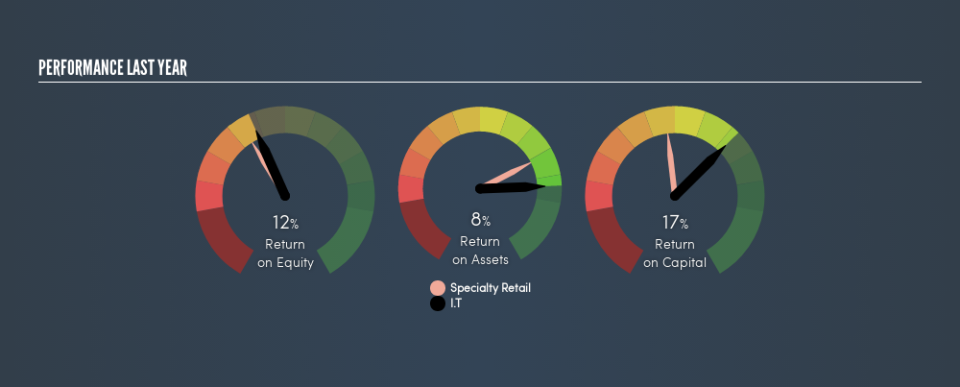I.T Limited (HKG:999) Is Employing Capital Very Effectively

Want to participate in a short research study? Help shape the future of investing tools and you could win a $250 gift card!
Today we'll evaluate I.T Limited (HKG:999) to determine whether it could have potential as an investment idea. To be precise, we'll consider its Return On Capital Employed (ROCE), as that will inform our view of the quality of the business.
First of all, we'll work out how to calculate ROCE. Then we'll compare its ROCE to similar companies. And finally, we'll look at how its current liabilities are impacting its ROCE.
What is Return On Capital Employed (ROCE)?
ROCE measures the amount of pre-tax profits a company can generate from the capital employed in its business. Generally speaking a higher ROCE is better. Ultimately, it is a useful but imperfect metric. Renowned investment researcher Michael Mauboussin has suggested that a high ROCE can indicate that 'one dollar invested in the company generates value of more than one dollar'.
How Do You Calculate Return On Capital Employed?
The formula for calculating the return on capital employed is:
Return on Capital Employed = Earnings Before Interest and Tax (EBIT) ÷ (Total Assets - Current Liabilities)
Or for I.T:
0.17 = HK$763m ÷ (HK$6.1b - HK$1.7b) (Based on the trailing twelve months to February 2019.)
So, I.T has an ROCE of 17%.
See our latest analysis for I.T
Is I.T's ROCE Good?
ROCE can be useful when making comparisons, such as between similar companies. I.T's ROCE appears to be substantially greater than the 13% average in the Specialty Retail industry. We consider this a positive sign, because it suggests it uses capital more efficiently than similar companies. Independently of how I.T compares to its industry, its ROCE in absolute terms appears decent, and the company may be worthy of closer investigation.
In our analysis, I.T's ROCE appears to be 17%, compared to 3 years ago, when its ROCE was 11%. This makes us think about whether the company has been reinvesting shrewdly. You can click on the image below to see (in greater detail) how I.T's past growth compares to other companies.
When considering this metric, keep in mind that it is backwards looking, and not necessarily predictive. Companies in cyclical industries can be difficult to understand using ROCE, as returns typically look high during boom times, and low during busts. ROCE is only a point-in-time measure. What happens in the future is pretty important for investors, so we have prepared a free report on analyst forecasts for I.T.
I.T's Current Liabilities And Their Impact On Its ROCE
Current liabilities include invoices, such as supplier payments, short-term debt, or a tax bill, that need to be paid within 12 months. Due to the way the ROCE equation works, having large bills due in the near term can make it look as though a company has less capital employed, and thus a higher ROCE than usual. To counteract this, we check if a company has high current liabilities, relative to its total assets.
I.T has total assets of HK$6.1b and current liabilities of HK$1.7b. As a result, its current liabilities are equal to approximately 28% of its total assets. A fairly low level of current liabilities is not influencing the ROCE too much.
What We Can Learn From I.T's ROCE
Overall, I.T has a decent ROCE and could be worthy of further research. I.T shapes up well under this analysis, but it is far from the only business delivering excellent numbers . You might also want to check this free collection of companies delivering excellent earnings growth.
If you are like me, then you will not want to miss this free list of growing companies that insiders are buying.
We aim to bring you long-term focused research analysis driven by fundamental data. Note that our analysis may not factor in the latest price-sensitive company announcements or qualitative material.
If you spot an error that warrants correction, please contact the editor at editorial-team@simplywallst.com. This article by Simply Wall St is general in nature. It does not constitute a recommendation to buy or sell any stock, and does not take account of your objectives, or your financial situation. Simply Wall St has no position in the stocks mentioned. Thank you for reading.

